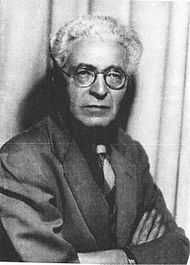Lajos Egri
| Lajos Egri | |
|---|---|
 Lajos Egri | |
| Born |
June 4, 1888 Eger, Hungary (then in Austria-Hungary) |
| Died |
February 7, 1967 (age 78) Los Angeles, California |
| Occupation | teacher of creative writing |
| Known for | treatise on playwriting |
| Spouse(s) | Ilona Egri (April 18, 1907 - 1967, his death) |
Lajos N. Egri (born June 4, 1888; died February 7, 1967) was the author of The Art of Dramatic Writing, which is widely regarded as one of the best works on the subject of playwriting, though its teachings have since been adapted for the writing of short stories, novels, and screenplays.[1] He is also the author of the companion textbook. The Art of Creative Writing, which further expounds on similar subjects.
Early years
Egri came to the US in 1906 and worked in a New York garment factory as a tailor and presser. He was an active member of the International Ladies' Garment Workers Union.[2]
Playwright
Egri wrote his first three act play at the age of ten, according to his biographical sketch in The Art of Dramatic Writing. In 1927, Rapid Transit, Egri's expressionist play, was translated from Hungarian and produced at the Provincetown Playhouse in New York. Casting about for some adequate means of conveying a sense of the furious pace of this machine age, Egri pictured a world in which all of life is compressed into twenty-four hours. Children grow to maturity in a few minutes; meals are eaten in split seconds; tabloid newspapers are issued at intervals of a second or two, and the loss of half a minute is a serious matter. The New York Times described the play as "chaotic at times, but sporadically interesting." [3] Egri was also author of other plays, among them the satirical comedy Believe Me or Not (1933), Tornado (1938), This is Love (1945 with Arden Young) and The Cactus Club (1957). His one act Hungarian plays include Satan is Dead, Spiders, Between Two Gods, There Will be No Performance, and Devils.
Teacher of Playwriting
Egri taught courses in playwriting, first in New York (1860 Broadway and 2 Columbus Circle), and then in Los Angeles. One student who garnered much attention was a 63 year old grandmother, Mrs. Esther Kaufman, who attended Egri's classes. Egri encouraged Mrs. Kaufman to write a play about growing up on the Lower East Side. The result was A Worm in the Horseradish, which had its premiere at the Maidman Theater in New York, March 13, 1961, and closed May 28 after mixed reviews.[4] Egri also worked with other playwrights and screenwriters, including Woody Allen, who took Egri's course at 2 Columbus Circle. "I still think his The Art of Dramatic Writing is the most stimulating and best book on the subject ever written, and I have them all," Allen told biographer Eric Lax.[5]
The Art of Dramatic Writing
Originally published by Simon and Schuster in 1942 as How to Write a Play, Egri's treatise was revised and published as The Art of Dramatic Writing in 1946.
Egri argues in The Art of Dramatic Writing against Aristotle's view of character being secondary to plot (as stated in Aristotle's Poetics). According to Egri, well defined characters will drive the plot themselves, and so the foundation of character is the essential germination of a well crafted story.
Central to Egri's argument is his claim that the best stories follow the logical method of thesis, antithesis, synthesis, or dialectic, to prove what he calls a "premise." A premise, as Egri describes it, is a thematic truth. In The Art of Dramatic Writing he offers as an example the premise that "stinginess leads to ruin." Having settled on this theme, Egri writes, the playwright can detect in the statement the suggestion of a story's beginning, middle, and end: first, the establishment of an obsessively stingy character; next, the collision of that character's stinginess with inevitable opposition, or antithesis; and finally the character's ruin. Egri also emphasizes what he sees as the ever-present role of change in all forms of life, forcing people to evolve and synthesize new philosophies in the face of one overwhelming obstacle after another.[6]
In 1965, Egri expanded on his views of character development and motivation in the book, The Art of Creative Writing.
Later life
Egri taught creative writing in his West Los Angeles home (at 11635 Mayfield Avenue) until shortly before his death. He died of a heart attack at Cedars of Lebanon Hospital.[7]
References
- ↑ Tibor Szy. Hungarians in America: a biographical directory of professionals of Hungarian origin in the Americas. Hungarian University Association. New York 1963 p 95
- ↑ A tailor turns author. New York Times. April 17, 1927.
- ↑ Rapid Transit depicts swift moving world. New York Times. April 8, 1927
- ↑ Lewis Funke. A GRANDMOTHER ENTERS THEATRE. At 63, She is About to Have First Play Produced About Life on Lower East Side. New York Times. February 14, 1961
- ↑ Woody Allen: a biography By Eric Lax. Da Capo Press; New edition (December 26, 2000) p 74
- ↑ Lajos Egri, The Art of Dramatic Writing, Simon & Schuster, 2004.
- ↑ Lajos Egri, 79 (sic). Writing teacher. New York Times, February 10, 1967
External links
- Premise - chapter 1 of The Art of Dramatic Writing
- Rapid Transit on the Internet Broadway Database
- TIME review of Rapid Transit
|